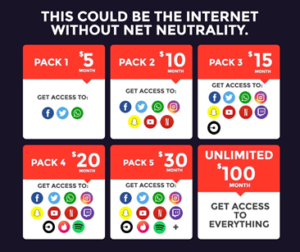
Ed. Note: This post by Prateek Surisetti is a part of the TLF Editorial Board Test 2018
Prior to delving into the economic considerations relevant to imposition of Net Neutrality (Part II), it would be in the best interest of comprehension to initiate the discussion with a brief overview of the market players and the nature of the market. The relevant market, here, is the Internet Service Provider (ISP) market (Part I).
Relevant Market Players
The significant players include the End Consumers or End Users (Users), the Content Providers (CPs) and the Platform Managers or Internet Service Providers (PMs).
The platform is run by Hosting Connectivity Providers and Internet Service Providers. The roles of both these entities are generally played by the same organization. The PMs are paid by both the CPs and the Users. The CPs, such as web content developers (e.g. Google), pay to get access to the Users via the ISP, while the Users pay the ISP to get access to the internet. So, the ISP serves as a gatekeeper of the internet to the Users.
Thereby, ISPs enjoy a position of power in relation to the both of the other players. With the advent of Deep Packet Inspection technology, ISPs have gained further more leverage over other players as they can, now, get to know the nature of data that is being transferred through its network, and consequently act in a manner which suits their commercial interests.
Basic Market Nature
The ISP market is a two-sided market.
On one side, you have the Users (regular internet users) and on the other you have CPs. In a two-sided market, the benefit accrued out of a service increases with greater participation from either side. To explain further, the value of a platform provided by an ISP will be greater for a CP, if the ISP has a larger User base. At the same time, Users will benefit as a result of greater content facilitated by greater participation from CPs.
Now, let us look at the consequences of the said market ecosystem.
Consequences of a Two-Sided Market
As stated earlier, the market’s structure incentivizes PMs to encourage participation from both CPs and Users. Consequently, PMs attempt to keep prices as low as possible for either side of the market. In other words, the market structure’s resultant effect is a downward push on prices.
While the discussion above seems to suggest that market prices tend to be on the lower side for both sides, it is pertinent to note that there exist other economic phenomena that could push the price upwards on the CPs side, namely the “waterbed effect” and demand elasticity
The “waterbed effect”, a theory linked with two-sided markets, primarily suggests that changes in pricing on either side of the market would be nullified by a corresponding opposite change on the other side. Now, let us look at the ISP market to determine whether CPs & Users share the costs proportionately or otherwise.
Given that Users generally purchase access to only one of the many platforms provided by multiple ISPs, CPs have to make sure that they are accessible on most of the platforms for furthering maximum reach. Since the burden lies on the CP to ensure that its content is available on every significant platform, ISPs exercise considerable leverage over CPs.
As a consequence of the power imbalance referred above, ISPs could maximize upon circumstances and encumber CPs with a greater proportion of the costs, as compared to Users. While the said analysis is based on the assumption that PMs/ISPs are more concerned about cornering the Users, as opposed to CPs, I submit the same isn’t an unreasonable assumption to make because, CPs, driven by the profit motive, are more enthusiastic about accessing Users than the other way round. In other words, the ISPs know that the CPs will necessarily shell out relatively higher fees for access to their platform, as long as a considerable portion of the Users rely on the said platform.
Moving on, ISPs also consider demand elasticity on either side of the market, while deciding upon pricing. Given that demand is less elastic (more price sensitive) on the side of the Users, they enjoy the benefit of relatively negligible prices. To rephrase, ISPs realize that Users, naturally having lesser financial capabilities than most CP businesses, would be more sensitive to changes in prices and therefore, to avoid antagonizing Users and consequently, causing a reduction in demand, ISPs prudently avoid changing prices on the User side of the market.
Chief References
Sridhar V & Rohit Prasad’s The Economics of Net Neutrality. Further here & here.
Image taken from here.